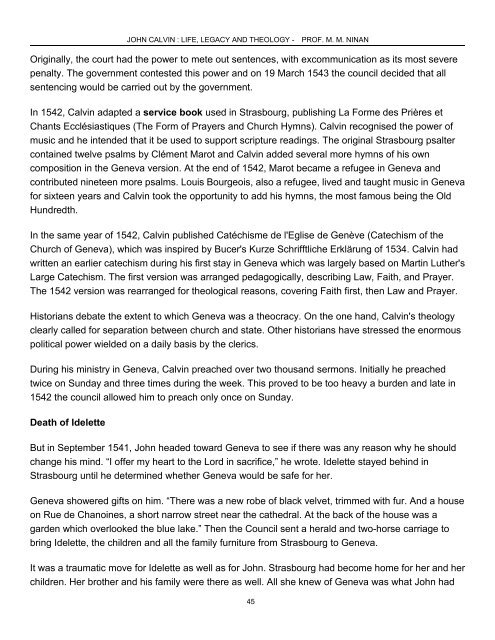You also want an ePaper? Increase the reach of your titles
YUMPU automatically turns print PDFs into web optimized ePapers that Google loves.
JOHN CALVIN : LIFE, LEGACY AND THEOLOGY -<br />
PROF. M. M. NINAN<br />
Originally, the court had the power to mete out sentences, with excommunication as its most severe<br />
penalty. The government contested this power <strong>and</strong> on 19 March 1543 the council decided that all<br />
sentencing would be carried out by the government.<br />
In 1542, <strong>Calvin</strong> adapted a service book used in Strasbourg, publishing La Forme des Prières et<br />
Chants Ecclésiastiques (The Form of Prayers <strong>and</strong> Church Hymns). <strong>Calvin</strong> recognised the power of<br />
music <strong>and</strong> he intended that it be used to support scripture readings. The original Strasbourg psalter<br />
contained twelve psalms by Clément Marot <strong>and</strong> <strong>Calvin</strong> added several more hymns of his own<br />
composition in the Geneva version. At the end of 1542, Marot became a refugee in Geneva <strong>and</strong><br />
contributed nineteen more psalms. Louis Bourgeois, also a refugee, lived <strong>and</strong> taught music in Geneva<br />
for sixteen years <strong>and</strong> <strong>Calvin</strong> took the opportunity to add his hymns, the most famous being the Old<br />
Hundredth.<br />
In the same year of 1542, <strong>Calvin</strong> published Catéchisme de l'Eglise de Genève (Catechism of the<br />
Church of Geneva), which was inspired by Bucer's Kurze Schrifftliche Erklärung of 1534. <strong>Calvin</strong> had<br />
written an earlier catechism during his first stay in Geneva which was largely based on Martin Luther's<br />
Large Catechism. The first version was arranged pedagogically, describing Law, Faith, <strong>and</strong> Prayer.<br />
The 1542 version was rearranged for theological reasons, covering Faith first, then Law <strong>and</strong> Prayer.<br />
Historians debate the extent to which Geneva was a theocracy. On the one h<strong>and</strong>, <strong>Calvin</strong>'s theology<br />
clearly called for separation between church <strong>and</strong> state. Other historians have stressed the enormous<br />
political power wielded on a daily basis by the clerics.<br />
During his ministry in Geneva, <strong>Calvin</strong> preached over two thous<strong>and</strong> sermons. Initially he preached<br />
twice on Sunday <strong>and</strong> three times during the week. This proved to be too heavy a burden <strong>and</strong> late in<br />
1542 the council allowed him to preach only once on Sunday.<br />
Death of Idelette<br />
But in September 1541, <strong>John</strong> headed toward Geneva to see if there was any reason why he should<br />
change his mind. “I offer my heart to the Lord in sacrifice,” he wrote. Idelette stayed behind in<br />
Strasbourg until he determined whether Geneva would be safe for her.<br />
Geneva showered gifts on him. “There was a new robe of black velvet, trimmed with fur. And a house<br />
on Rue de Chanoines, a short narrow street near the cathedral. At the back of the house was a<br />
garden which overlooked the blue lake.” Then the Council sent a herald <strong>and</strong> two-horse carriage to<br />
bring Idelette, the children <strong>and</strong> all the family furniture from Strasbourg to Geneva.<br />
It was a traumatic move for Idelette as well as for <strong>John</strong>. Strasbourg had become home for her <strong>and</strong> her<br />
children. Her brother <strong>and</strong> his family were there as well. All she knew of Geneva was what <strong>John</strong> had<br />
45

















